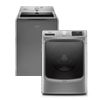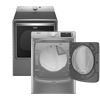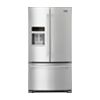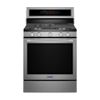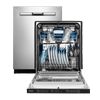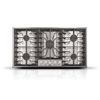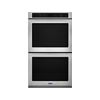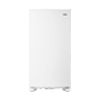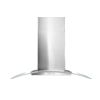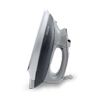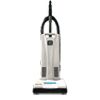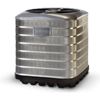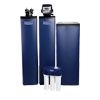Cleaning and Maintenance of Range
Cleaning and Maintenance for Maytag Range
Maintaining the cleanliness and functionality of your Maytag range is crucial for both its performance and longevity. This comprehensive guide provides detailed instructions on how to effectively clean and care for various components of your range, from the porcelain and ceramic cooktops to the exterior finishes and removable parts. It includes essential pre-cleaning preparations and the best practices for using cleaning products, ensuring that you preserve the pristine condition of your appliance while preventing damage. Whether dealing with routine maintenance or addressing spills and residues, these tips will help keep your range looking and operating like new.
General Tips
- Pre-Cleaning Preparation: Always ensure the appliance is switched off and completely cool before beginning any cleaning task to ensure safety.
- Use of Cleaning Products: Follow the manufacturer's instructions for any commercial cleaning product. This is crucial not only for safety but also to avoid inadvertently damaging the appliance's surfaces.
- Food spills containing acids like vinegar and tomato should be cleaned as soon as the appliance is cool. These spills may affect the finish.
By integrating these practices into your routine, you can keep your range and oven clean and enhance their performance and longevity.
Cleaning the Cooktop
Porcelain Cooktop: Preferred Method: Soap, water, and a soft cloth or sponge are suggested first unless otherwise noted—other Methods: Glass cleaner, mild liquid detergent, all-purpose cleaner, or nonabrasive scrubbing pad. Rinse with clean water and dry with a soft, lint-free cloth. To avoid damage to porcelain surfaces, do not use soap-filled scouring pads, abrasive cleaners, steel wool pads, gritty washcloths, or abrasive paper towels.
Ceramic Cooktop: Remove food/residue with a scraper designed for ceramic glass cooktops. Apply a few dime-sized drops of affresh® cooktop cleaner / ceramic glass cooktop cleaner to the affected areas. Polish with a clean, dry cloth or a clean, dry paper towel.
Cleaning the Exterior
Control Panel/Display: First, use soap, water, and a soft cloth or sponge. Then, if needed, use a glass cleaner, mild liquid detergent, all-purpose cleaner, or a nonabrasive scrubbing pad. Rinse with clean water and dry with a soft, lint-free cloth.
Painted, Metallic, and Fingerprint-Resistant Finishes: Soap, water, and a soft cloth or sponge are suggested first unless otherwise noted in the Owner's Manual.
Stainless Steel Finishes: Wipe the stainless steel in the direction of the grain to avoid damage. Wipe off any excess and use special care to avoid contact with plastic parts, trim pieces, or rubber door gaskets. If the polish does contact any of these plastic parts, clean them with a nonabrasive sponge and mild detergent in warm water.
Cleans even where you can't see
affresh® cleans deep inside your appliances reaching components such as the tub, racks, pump, valves, drain, and recirculation hoses.
Cleaners are available at many retailers or can be purchased here at affresh®.

Cleaning the Removable Components
NOTE: Coil elements are self-cleaning; do not immerse them in water. The drip bowls should be removed before cleaning.
Chrome Drip Bowls: Clean the drip bowl with liquid detergent or all-purpose cleaner, rinse with clean water, and dry with a soft cloth. Bowls can also be cleaned with an ammonia solution. Mix ½ cup (125 mL) ammonia with 1 gal. (3.75 L) water. Soak for 20 minutes, then scrub with a stainless steel wool pad; if needed, use a mildly abrasive cleanser and clean with a wet scouring pad.
Porcelain Drip Bowls: Place in the dishwasher or clean the drip bowl with liquid detergent or all-purpose cleaner, rinse with clean water, and dry with a soft cloth.
Oven Racks: Clean oven racks with liquid detergent or all-purpose cleaner, rinse, and dry. A steel wool pad can be used to remove stains or residue that are harder to remove. For discolored racks that are harder to slide, a light coating of vegetable oil applied to the rack guides will help them slide.
Control Knobs: Remove the knobs and use soap, water, and a soft cloth or sponge to clean. To avoid damage, do not soak the knobs or use steel wool, abrasive cleaners, or oven cleaner.
Cleaning the Oven
Odors and Smells of Newly Installed Ovens
IMPORTANT: Do not line the oven bottom with foil or a liner to avoid permanent damage to the finish. Covering the bottom can trap spills and debris, resulting in odors. The health of some birds are extremely sensitive to the fumes given off. Exposure to fumes may result in the death of certain birds. Always move birds to another closed and well-ventilated room.
A small amount of smoke or odor can be normal, especially the first time a new range or oven is used. It is caused by the heating of new parts, insulating materials, a protective coating of oil used in the manufacturing process, and/or the tape used in shipping. It should dissipate after the first few uses. The best way to eliminate the smell is to run an empty cycle. It is recommended that you do not cook any food before this cycle as the smell and, potentially, the taste can stick with your food. For people sensitive to strong odors or smoke, open nearby windows and/or turn on a kitchen vent (if available). Doing this will help dissipate the new oven odor.
If you want to get rid of the odor in the oven more quickly, we recommend the following: Ensure all packaging materials have been removed from the oven cavity. Set the oven to a “Bake” cycle, setting the temperature to 350 degrees. Continue running the cycle for 60 minutes. If the smell persists after the cycle, repeat the process. Once the oven cavity is cool, wipe down the interior with a soft, damp cloth.
Routine Oven Cleaning
Performing regular light oven cleaning after a spill will help avoid soil build-up and will make it easier to maintain the oven's appearance. Use a mixture of liquid detergent or all-purpose cleaner and water. Apply with a soft sponge or cloth, rinse with clean water, and allow it to dry. After each cleaning session, whether light or deep, it’s good to check the oven's seals and gaskets. A broken seal can lead to heat loss, which affects the oven’s efficiency and increases cooking times.
Deep cleaning of the oven will depend on its frequency of use and the soil level on its interior. Understanding the type of self-cleaning technology your oven uses is crucial. High-temperature self-cleaning cycles are effective but can produce smoke and odors. The AquaLift™ technology, by contrast, is a gentler method that reduces odors and uses lower temperatures but may require repeated cycles for heavily soiled ovens.
High Temp - Self Clean Cycle
The Self-Cleaning cycle uses very high temperatures, burning soil to a powdery ash. Self-clean the oven before it becomes heavily soiled. Heavy soil results in longer cleaning and more smoke. Keep the kitchen well-ventilated during the Self-Cleaning cycle to help get rid of heat, odors, and smoke. Do not block the oven vent(s) during the Self-Cleaning cycle. Air must be able to move freely. Do not clean, rub, damage, or move the oven door gasket. The door gasket is essential for a good seal.
Check out High Temperature Self-Clean Cycle Information for more information.
AquaLiftTM Self-Cleaning:
AquaLiftTM self-clean technology is a low-heat, virtually no-odor alternative to traditional 800o F self-cleaning options. It uses a cleaning solution activated with heat and water to release touch baked-on soils from the oven interior.
The most effective method to remove difficult soils that are not clean after the cycle is to run another cycle. This second cycle may be necessary if the soil is excessively thick or has a large surface area. The first cycle will make the soil thinner and the surface area smaller. The second cycle will be more effective at lifting the soil since it is now smaller. The use of a non-scratch sponge or plastic scraper is also suggested.


